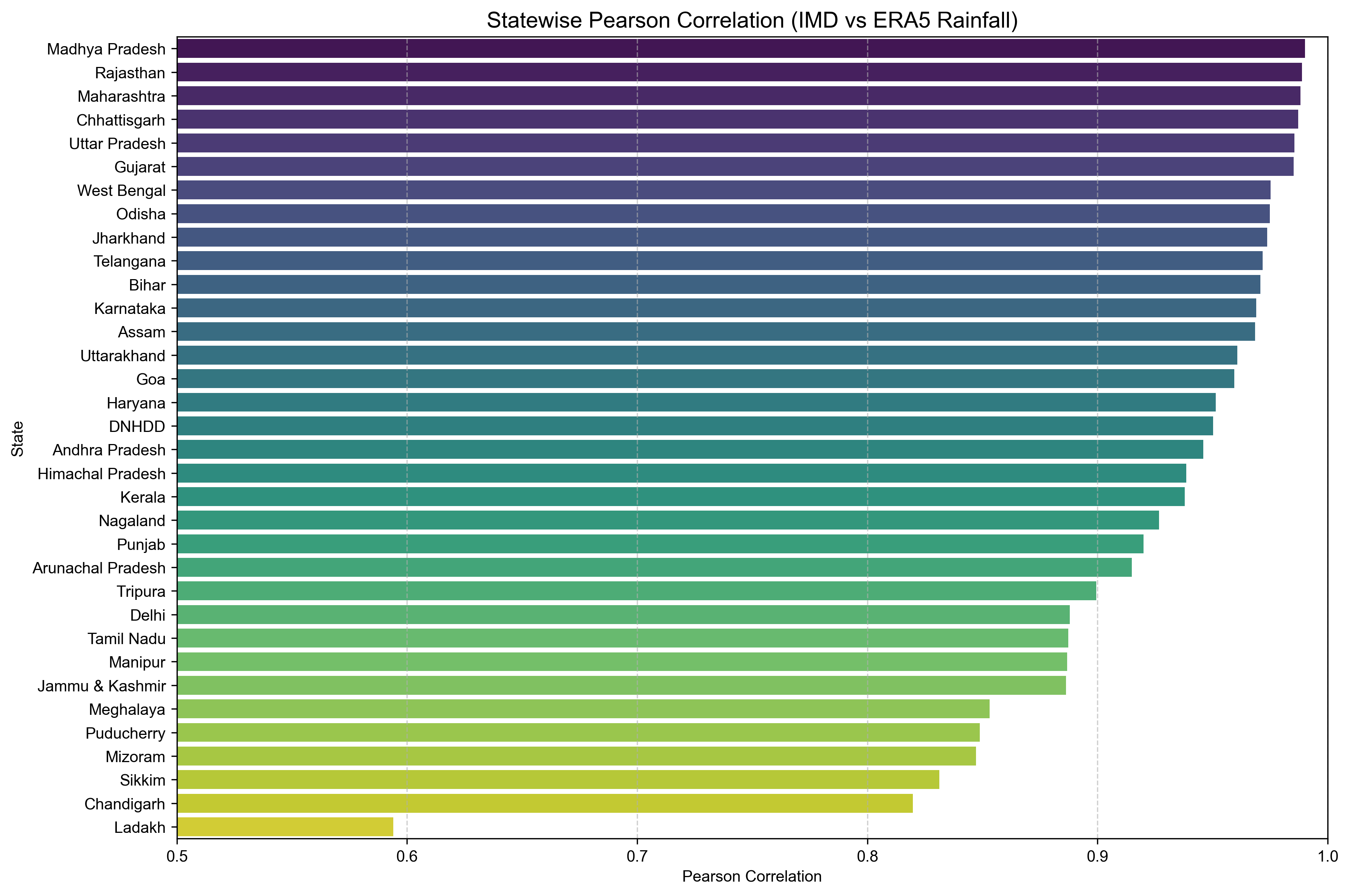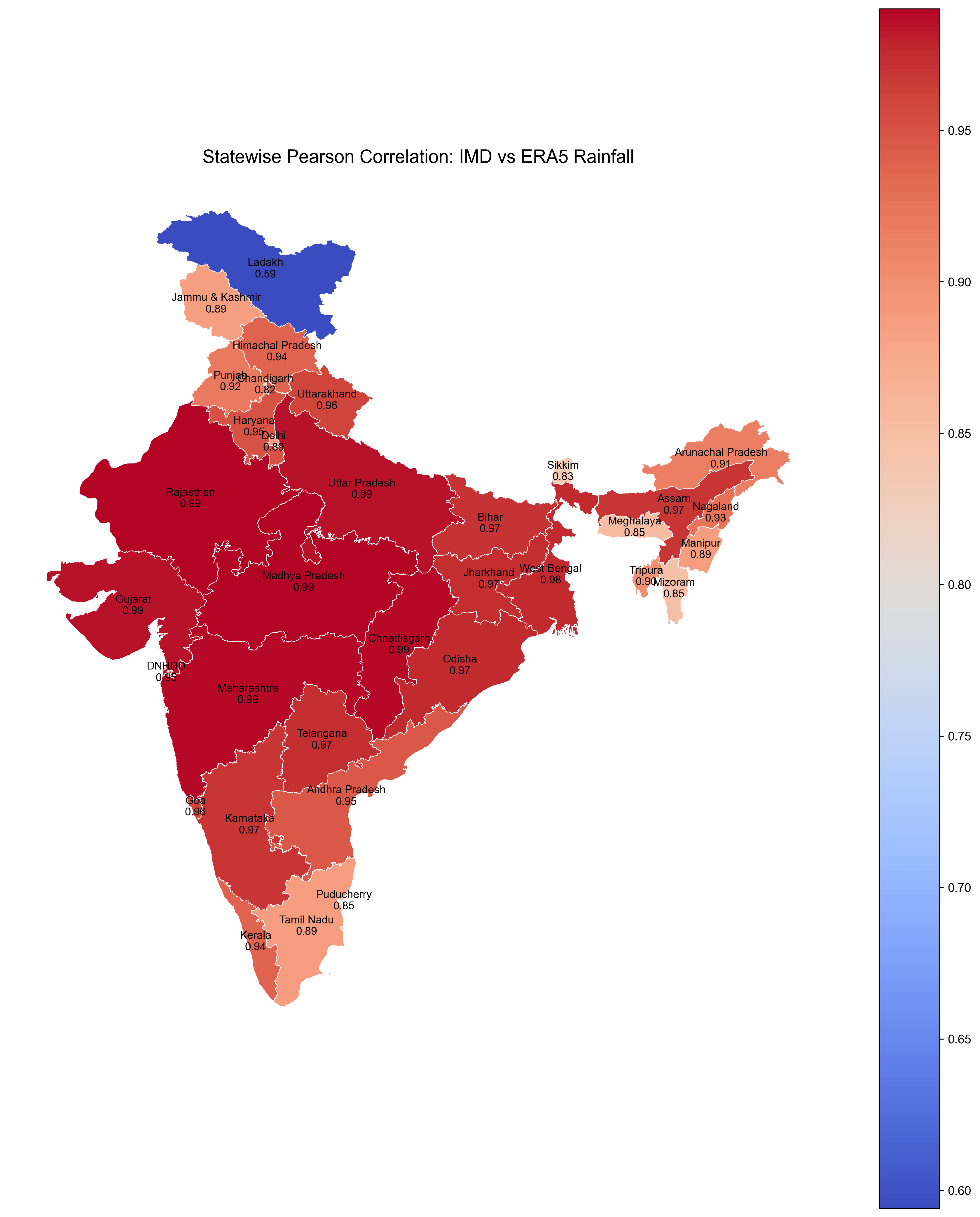Comparison of ERA5 and IMD Monthly Rainfall Across Indian States (2000–2024)#
In this notebook, we analyze and compare monthly precipitation patterns across Indian states using two key datasets:
ERA5 (climate reanalysis from ECMWF)
IMD (Indian Meteorological Department gridded rainfall data)
We focus on:
Harmonizing ERA5 and IMD rainfall data at the state level
Evaluating the correlation between ERA5 and IMD rainfall for each state
Visualizing the spatial pattern of Pearson correlations to assess agreement between datasets
We use:
varunayanfor extracting ERA5 monthly precipitation (2000–2024)imdlibfor downloading IMD monthly rainfall data
This study provides insights into how well ERA5 captures regional rainfall variability in India compared to IMD observations, which could be important for validating ERA5 use in climate research and studies for India.
Step 1: Extract ERA5 Rainfall Data for India#
We use varunayan to download monthly total precipitation (tp) from the ERA5 climate reanalysis dataset for the Indian region from 2000 to 2024.
North: 37.5°, South: 6°, East: 97.5°, West: 68°
Resolution: 0.25°
Frequency: Monthly
Units: meters/day
We will be using the raw data acquired using varunayan for this analysis.
import varunayan
import pandas as pd
varunayan.era5ify_bbox(
request_id='rainfall_Indian_region',
variables=['total_precipitation'],
start_date='2000-1-1',
end_date='2024-12-31',
north=37.5,
south=6,
east=97.5,
west=68,
frequency='monthly',
resolution=0.25
)
============================================================
STARTING ERA5 SINGLE LEVEL PROCESSING
============================================================
Request ID: rainfall_Indian_region
Variables: ['total_precipitation']
Date Range: 2000-01-01 to 2024-12-31
Frequency: monthly
Resolution: 0.25°
Saving files to output directory: rainfall_Indian_region_output
Saved final data to: rainfall_Indian_region_output\rainfall_Indian_region_monthly_data.csv
Saved unique coordinates to: rainfall_Indian_region_output\rainfall_Indian_region_unique_latlongs.csv
Saved raw data to: rainfall_Indian_region_output\rainfall_Indian_region_raw_data.csv
============================================================
PROCESSING COMPLETE
============================================================
RESULTS SUMMARY:
----------------------------------------
Variables processed: 1
Time period: 2000-01-01 to 2024-12-31
Final output shape: (300, 3)
Total complete processing time: 151.79 seconds
First 5 rows of aggregated data:
tp year month
0 0.036963 2000 1
1 0.033683 2000 2
2 0.044679 2000 3
3 0.055403 2000 4
4 0.128061 2000 5
============================================================
ERA5 SINGLE LEVEL PROCESSING COMPLETED SUCCESSFULLY
============================================================
| tp | year | month | |
|---|---|---|---|
| 0 | 0.036963 | 2000 | 1 |
| 1 | 0.033683 | 2000 | 2 |
| 2 | 0.044679 | 2000 | 3 |
| 3 | 0.055403 | 2000 | 4 |
| 4 | 0.128061 | 2000 | 5 |
| ... | ... | ... | ... |
| 295 | 0.261888 | 2024 | 8 |
| 296 | 0.177968 | 2024 | 9 |
| 297 | 0.133740 | 2024 | 10 |
| 298 | 0.088298 | 2024 | 11 |
| 299 | 0.068547 | 2024 | 12 |
300 rows × 3 columns
Step 2: Process ERA5 Monthly Rainfall Data#
We process the downloaded ERA5 dataset to compute total monthly rainfall in millimeters and aggregate it at the state level.
Key steps:#
Convert to Monthly Rainfall (mm)
Multiply
tp(meters/day) by number of days in month × 1000Final unit: millimeters per month
Assign State Names to Grid Points
Convert each
(lat, lon)point to aPointgeometryPerform a spatial join with Indian district boundaries to assign the corresponding state
Statewise Monthly Aggregation
Compute the rainfall per state per month
The result is a dataframe (statewise_monthly_prec_era5) with:
month,state_name,monthly_rain_mm
df_raw_prec = pd.read_csv('rainfall_Indian_region_output/rainfall_Indian_region_raw_data.csv')
import numpy as np
df_raw_prec['month'] = pd.to_datetime(df_raw_prec['date']).dt.month
df_raw_prec['date'] = pd.to_datetime(df_raw_prec['date'])
df_raw_prec['days_in_month'] = df_raw_prec['date'].dt.days_in_month
# Convert tp (precipitation in m/day) -> total monthly precipitation (in meters) -> total monthly precipitation (in mm)
df_raw_prec['tp'] = df_raw_prec['tp'] * df_raw_prec['days_in_month'] * 1000
import geopandas as gpd
from shapely.geometry import Point
df_raw_prec['geometry'] = df_raw_prec.apply(
lambda row: Point(row['longitude'], row['latitude']), axis=1
)
gdf_prec = gpd.GeoDataFrame(df_raw_prec, geometry='geometry', crs='EPSG:4326')
url = "https://bharatviz.saketlab.in/India_LGD_Districts_simplified.geojson"
districts_gdf = gpd.read_file(url)
gdf_joined = gpd.sjoin(
gdf_prec,
districts_gdf[['state_name', 'geometry']],
how='left',
predicate='within'
)
gdf_joined = gdf_joined.dropna(subset=['state_name'])
statewise_monthly_prec_era5 = (
gdf_joined.groupby(['date', 'state_name'], as_index=False)['tp'].mean()
.rename(columns={'tp': 'monthly_rain_mm'})
)
statewise_monthly_prec_era5
| date | state_name | monthly_rain_mm | |
|---|---|---|---|
| 0 | 2000-01-01 | A & N Islands | 38.449201 |
| 1 | 2000-01-01 | Andhra Pradesh | 1.987584 |
| 2 | 2000-01-01 | Arunachal Pradesh | 147.174445 |
| 3 | 2000-01-01 | Assam | 32.347206 |
| 4 | 2000-01-01 | Bihar | 1.555414 |
| ... | ... | ... | ... |
| 10495 | 2024-12-01 | Telangana | 19.974696 |
| 10496 | 2024-12-01 | Tripura | 0.528455 |
| 10497 | 2024-12-01 | Uttar Pradesh | 17.636980 |
| 10498 | 2024-12-01 | Uttarakhand | 51.980734 |
| 10499 | 2024-12-01 | West Bengal | 4.839537 |
10500 rows × 3 columns
statewise_monthly_prec_era5.to_csv('era5_monthly_statewise_rain.csv', index=False)
Step 3: Extract IMD Gridded Rainfall Data#
We use the imdlib package to download gridded IMD rainfall data over India for the same period: 2000–2024.
Variable:
'rain'Format:
monthwiseGrid resolution: 0.25°
Units: mm
This dataset provides observational rainfall data from IMD’s high-quality station network.
import imdlib as imd
start_yr = 2000
end_yr = 2024
variable = 'rain'
imd.get_data(variable, start_yr, end_yr, fn_format='monthwise')
Downloading: rain for year 2000
Downloading: rain for year 2001
Downloading: rain for year 2002
Downloading: rain for year 2003
Downloading: rain for year 2004
Downloading: rain for year 2005
Downloading: rain for year 2006
Downloading: rain for year 2007
Downloading: rain for year 2008
Downloading: rain for year 2009
Downloading: rain for year 2010
Downloading: rain for year 2011
Downloading: rain for year 2012
Downloading: rain for year 2013
Downloading: rain for year 2014
Downloading: rain for year 2015
Downloading: rain for year 2016
Downloading: rain for year 2017
Downloading: rain for year 2018
Downloading: rain for year 2019
Downloading: rain for year 2020
Downloading: rain for year 2021
Downloading: rain for year 2022
Downloading: rain for year 2023
Downloading: rain for year 2024
Download Successful !!!
<imdlib.core.IMD at 0x18e32d9a3c0>
Step 4: Process IMD Data to Statewise Monthly Rainfall#
We convert the IMD gridded dataset into a statewise monthly rainfall dataset to match the format of ERA5.
Key steps:#
Convert to DataFrame
Extract data from the
xarrayobjectDrop missing values (
-999.0)
Aggregate Monthly Rainfall
Sum rainfall for each month at each grid point
Create Point geometries and spatially join with state boundaries
Statewise Monthly Average
Group by
state_nameandmonthCalculate average monthly rainfall
Output: statewise_monthly_prec_imd
import numpy as np
data = imd.open_data(variable, start_yr, end_yr,'monthwise')
ds = data.get_xarray()
df = ds.to_dataframe().reset_index()
df['rain'] = df['rain'].replace(-999.0, np.nan)
df
| time | lat | lon | rain | |
|---|---|---|---|---|
| 0 | 2000-01-01 | 6.5 | 66.50 | NaN |
| 1 | 2000-01-01 | 6.5 | 66.75 | NaN |
| 2 | 2000-01-01 | 6.5 | 67.00 | NaN |
| 3 | 2000-01-01 | 6.5 | 67.25 | NaN |
| 4 | 2000-01-01 | 6.5 | 67.50 | NaN |
| ... | ... | ... | ... | ... |
| 159033775 | 2024-12-31 | 38.5 | 99.00 | NaN |
| 159033776 | 2024-12-31 | 38.5 | 99.25 | NaN |
| 159033777 | 2024-12-31 | 38.5 | 99.50 | NaN |
| 159033778 | 2024-12-31 | 38.5 | 99.75 | NaN |
| 159033779 | 2024-12-31 | 38.5 | 100.00 | NaN |
159033780 rows × 4 columns
df['time'] = pd.to_datetime(df['time'])
df['month'] = df['time'].dt.to_period('M')
grouped_df = df.groupby(['month', 'lat', 'lon'], as_index=False)['rain'].sum()
grouped_df
| month | lat | lon | rain | |
|---|---|---|---|---|
| 0 | 2000-01 | 6.5 | 66.50 | 0.0 |
| 1 | 2000-01 | 6.5 | 66.75 | 0.0 |
| 2 | 2000-01 | 6.5 | 67.00 | 0.0 |
| 3 | 2000-01 | 6.5 | 67.25 | 0.0 |
| 4 | 2000-01 | 6.5 | 67.50 | 0.0 |
| ... | ... | ... | ... | ... |
| 5224495 | 2024-12 | 38.5 | 99.00 | 0.0 |
| 5224496 | 2024-12 | 38.5 | 99.25 | 0.0 |
| 5224497 | 2024-12 | 38.5 | 99.50 | 0.0 |
| 5224498 | 2024-12 | 38.5 | 99.75 | 0.0 |
| 5224499 | 2024-12 | 38.5 | 100.00 | 0.0 |
5224500 rows × 4 columns
import geopandas as gpd
from shapely.geometry import Point
df = grouped_df.copy()
df['geometry'] = df.apply(lambda row: Point(row['lon'], row['lat']), axis=1)
grid_gdf = gpd.GeoDataFrame(df, geometry='geometry', crs="EPSG:4326")
joined = gpd.sjoin(grid_gdf, districts_gdf[['state_name', 'geometry']], how='left', predicate='within')
statewise_monthly_prec_imd = joined.groupby(['month','state_name'], as_index=False)['rain'].mean()
statewise_monthly_prec_imd = statewise_monthly_prec_imd.dropna(subset=['state_name'])
statewise_monthly_prec_imd
| month | state_name | rain | |
|---|---|---|---|
| 0 | 2000-01 | A & N Islands | 0.000000 |
| 1 | 2000-01 | Andhra Pradesh | 0.055613 |
| 2 | 2000-01 | Arunachal Pradesh | 35.826280 |
| 3 | 2000-01 | Assam | 19.927342 |
| 4 | 2000-01 | Bihar | 0.523257 |
| ... | ... | ... | ... |
| 10495 | 2024-12 | Telangana | 17.484431 |
| 10496 | 2024-12 | Tripura | 5.540522 |
| 10497 | 2024-12 | Uttar Pradesh | 4.986236 |
| 10498 | 2024-12 | Uttarakhand | 31.285862 |
| 10499 | 2024-12 | West Bengal | 3.514762 |
10500 rows × 3 columns
statewise_monthly_prec_imd.to_csv('imd_monthly_statewise_rain.csv', index=False)
Step 5: Merge ERA5 and IMD Datasets#
We merge the two statewise monthly rainfall datasets (ERA5 and IMD) into a common format for comparison.
Align on:
month,state_nameRename columns to:
rain_imd(from IMD)rain_era5(from ERA5)
Final merged dataset: merged_df
statewise_monthly_prec_imd['month'] = statewise_monthly_prec_imd['month'].dt.to_timestamp()
statewise_monthly_prec_era5['date'] = pd.to_datetime(statewise_monthly_prec_era5['date'])
statewise_monthly_prec_era5 = statewise_monthly_prec_era5.rename(columns={'date': 'month'})
merged_df = pd.merge(
statewise_monthly_prec_imd,
statewise_monthly_prec_era5,
on=['month', 'state_name'],
how='left'
)
merged_df = merged_df.rename(columns={
'rain': 'rain_imd',
'monthly_rain_mm': 'rain_era5'
})
merged_df.to_csv('merged_imd_era5_state_rain.csv', index=False)
merged_df
| month | state_name | rain_imd | rain_era5 | |
|---|---|---|---|---|
| 0 | 2000-01-01 | A & N Islands | 0.000000 | 38.449201 |
| 1 | 2000-01-01 | Andhra Pradesh | 0.055613 | 1.987584 |
| 2 | 2000-01-01 | Arunachal Pradesh | 35.826280 | 147.174445 |
| 3 | 2000-01-01 | Assam | 19.927342 | 32.347206 |
| 4 | 2000-01-01 | Bihar | 0.523257 | 1.555414 |
| ... | ... | ... | ... | ... |
| 10495 | 2024-12-01 | Telangana | 17.484431 | 19.974696 |
| 10496 | 2024-12-01 | Tripura | 5.540522 | 0.528455 |
| 10497 | 2024-12-01 | Uttar Pradesh | 4.986236 | 17.636980 |
| 10498 | 2024-12-01 | Uttarakhand | 31.285862 | 51.980734 |
| 10499 | 2024-12-01 | West Bengal | 3.514762 | 4.839537 |
10500 rows × 4 columns
Step 6: Compute Statewise Pearson Correlation#
We compute the Pearson correlation coefficient between ERA5 and IMD rainfall for each state using the merged dataset.
Group by
state_nameCalculate correlation between
rain_imdandrain_era5Drop states with insufficient data (e.g., all-zero IMD values)
Final output: statewise_corr with:
state_name,pearson_corr
statewise_corr = (
merged_df
.dropna(subset=['rain_imd', 'rain_era5'])
.groupby('state_name')
.apply(lambda df: df.loc[:, ['rain_imd', 'rain_era5']].corr().iloc[0,1])
.reset_index(name='pearson_corr')
)
statewise_corr.to_csv('statewise_corr_imd_era5.csv', index=False)
C:\Users\Atharva Jagtap\AppData\Local\Temp\ipykernel_6688\3483317820.py:5: FutureWarning: DataFrameGroupBy.apply operated on the grouping columns. This behavior is deprecated, and in a future version of pandas the grouping columns will be excluded from the operation. Either pass `include_groups=False` to exclude the groupings or explicitly select the grouping columns after groupby to silence this warning.
.apply(lambda df: df.loc[:, ['rain_imd', 'rain_era5']].corr().iloc[0,1])
def setup_matplotlib():
try:
import matplotlib.pyplot as plt
except ImportError:
raise ImportError(
"Matplotlib is not installed. Install it with: pip install matplotlib"
)
plt.rcParams["figure.dpi"] = 300
plt.rcParams["savefig.dpi"] = 300
plt.rcParams["font.family"] = "sans-serif"
plt.rcParams["font.sans-serif"] = ["Arial"]
plt.rcParams["axes.labelweight"] = "normal"
plt.rcParams["mathtext.fontset"] = "custom"
plt.rcParams["mathtext.rm"] = "Arial"
plt.rcParams["mathtext.it"] = "Arial:italic"
plt.rcParams["mathtext.bf"] = "Arial:bold"
Visualize Correlation as Bar Plot#
We visualize the statewise Pearson correlations using a horizontal bar chart.
Sort states by correlation
Highlight high agreement (closer to 1.0)
Filter out NaN values (e.g., A & N Islands)
import pandas as pd
import matplotlib.pyplot as plt
import seaborn as sns
setup_matplotlib()
# Clean NaNs (for A & N Islands, since all the values for rainfall in IMD data are 0)
statewise_corr = statewise_corr.dropna(subset=['pearson_corr'])
statewise_corr_sorted = statewise_corr.sort_values('pearson_corr', ascending=False)
plt.figure(figsize=(12, 8))
sns.barplot(data=statewise_corr_sorted, x='pearson_corr', y='state_name', palette='viridis')
plt.title('Statewise Pearson Correlation (IMD vs ERA5 Rainfall)', fontsize=14)
plt.xlabel('Pearson Correlation')
plt.ylabel('State')
plt.xlim(0.5, 1.0)
plt.grid(axis='x', linestyle='--', alpha=0.6)
plt.tight_layout()
plt.show()
C:\Users\Atharva Jagtap\AppData\Local\Temp\ipykernel_6688\2650763813.py:13: FutureWarning:
Passing `palette` without assigning `hue` is deprecated and will be removed in v0.14.0. Assign the `y` variable to `hue` and set `legend=False` for the same effect.

Choropleth Map of Correlation by State#
We use a simplified India state GeoJSON to create a choropleth map showing the spatial pattern of correlation between ERA5 and IMD rainfall.
Features:#
Color scale (
coolwarm) for correlation valuesState labels and correlation values annotated
This visualization gives a spatial perspective on how well ERA5 agrees with IMD across different regions of India.
import geopandas as gpd
import pandas as pd
import matplotlib.pyplot as plt
setup_matplotlib()
geojson_url = "https://gist.githubusercontent.com/JaggeryArray/fa31964eedb0c2da023c9485772f911a/raw/02c0644de34fbae9dbac2ba0496a00772a2c28cd/india_map_states.geojson"
gdf = gpd.read_file(geojson_url)
gdf_merged = gdf.merge(statewise_corr, on='state_name', how='left')
fig, ax = plt.subplots(figsize=(12, 14))
gdf_merged.plot(
column='pearson_corr',
cmap='coolwarm',
linewidth=0.5,
edgecolor='white',
legend=True,
ax=ax
)
for idx, row in gdf_merged.dropna(subset=['pearson_corr']).iterrows():
centroid = row.geometry.centroid
label = f"{row['state_name']}\n{row['pearson_corr']:.2f}"
ax.text(centroid.x, centroid.y, label, fontsize=9, ha='center', va='center')
ax.set_title("Statewise Pearson Correlation: IMD vs ERA5 Rainfall", fontsize=15)
ax.axis('off')
plt.tight_layout()
plt.show()

